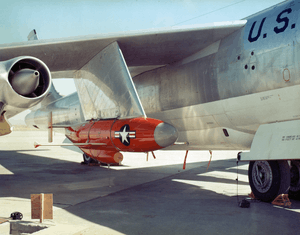GAM-67 Crossbow
| GAM-67 Crossbow | |
|---|---|
|
Crossbow on B-47 carrier aircraft | |
| Type | Anti-radar missile |
| Place of origin | United States |
| Production history | |
| Manufacturer | Northrop |
| Specifications | |
| Weight | 2,800 lb (1,270 kg) |
| Length | 19 ft 1 in (5.82 m) |
| Height | 4 ft 6 (1.37 m) |
|
| |
| Engine | Continental J69 turbojet |
| Wingspan | 12 ft 6 in (3.81 m) |
Operational range | 300 miles (480 km) |
| Flight altitude | 40,000 ft (12,200 m) |
| Speed | 675 mph (1,090 km/h) |
Launch platform | Aircraft or RATO |
The GAM-67 Crossbow was a jet-powered anti-radar missile built by Northrop's Ventura Division (successor to the Radioplane Company).
Development
In the late 1940s, the Radioplane Company developed a set of prototypes of the Q-1 target series, which used pulsejet or small turbojet engines. Although the Q-1 series was not put into production as a target, it did evolve into the USAF RP-54D / XB-67 / XGAM-67 Crossbow anti-radar missile, which was first flown in 1956. It was also considered as a platform for reconnaissance, electronic countermeasures, and decoy roles.
The Crossbow had a cigar-shaped fuselage, straight wings, a straight twin-fin tail, and an engine inlet under the belly. It was powered by a Continental J69 turbojet engine, with 4.41 kN (450 kgf/1,000 lbf) thrust. Two Crossbows could be carried by a Boeing B-50 Superfortress bomber, while four Crossbows could be carried by a Boeing B-47 Stratojet bomber.
Only 14 Crossbows were built before the program was cancelled in 1957, in favor of a more sophisticated system that ended up being cancelled in turn. However, it did point the way to the range of missions that would be performed by UAVs in later decades.
References
- This article contains material that originally came from the web article Unmanned Aerial Vehicles by Greg Goebel, which exists in the Public Domain.
